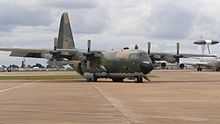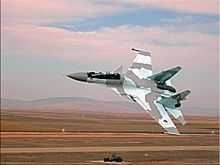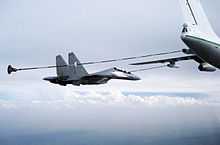Algerian Air Force
| Algerian Air Force القوات الجوية الجزائرية Al Quwwat aljawwiya aljaza'eriiya | |
|---|---|
 Badge of the Algerian Air Force | |
| Active | 1962 - present |
| Country |
|
| Type | Air Force |
| Size | 14,000 personnel |
| Insignia | |
| Roundel |
 |
| Aircraft flown | |
| Fighter | Su-30, MiG-29, Su-24, MiG-25 |
| Attack helicopter | Mi-24, Mi-28 |
| Interceptor | Su-30, MiG-25 |
| Patrol | Fokker F27, King Air |
| Reconnaissance | MiG-25, UAV Seeker, Su-24, B-1900D HISAR |
| Trainer | Z 142, T-34C, L-39, Yak-130 |
| Transport | C-130, Il-76, C-295 |
The Algerian Air Force (QJJ) (Arabic: القوات الجوية الجزائرية, Al Quwwat aljawwiya aljaza'eriiya), is the aerial arm of the Algerian People's Military.
History

Algerian military aviation was created to aid the fight of the People National Army against the French occupying forces. It came as part of the decisions of the Soummam congress held on August 20, 1956 which recommended a long term plan to form a modern army
From 1958 to 1962
A structure was created to receive the Algerian students of the People National Army, among which some were sent to sister and friendly countries such as Egypt, Iraq, Syria, USSR and China, to train as aircraft pilots and aeronautics technicians .
During this period, the French colonial army had started the lines of Challe and Morrice used to isolate the ALN fighters inside the country and to stop supplies coming from Tunisia and Morocco. Then came the idea to train transport and helicopter pilots to ensure supplying the national liberation army and to prepare the first core of the military aviation.
From 1962 to 1970
Training was one of the major preoccupations of the ALN/FLN leaders. Military aviation had a core of pilots and ASDFDASF technicians after independence, who laid the foundations of the present Air Force. The Direction of Air was born and the first air units of independent Algeria were set up i.e. a flight of helicopters that was acquired during the revolution, and a flight of combat aircraft.
The Algerians authorities sent trainees to friendly countries such Egypt, Syria, Iraq, China and USSR, while waiting for the creation of Algerian Air Force schools.
In 1966, the Air Base of Tafraoui in the 2nd Military Region was built as an air officers school (EOA) where the first officer students were received for the training of pilots and technicians in aeronautics. .
During this first decade, immediately after independence, the Algerian Air Force acquired planes from the USSR, mainly MiG-15UTI and MiG-17, and some donated by Egypt. When border clashes with Morocco occurred in 1963, the Algerian government decided to reinforce the capacities of the army and the air force. MiG-17F light bomber, MiG-21 F13 interceptor, Su-7BMK fighter/bomber and some An-12 airlifters were purchased from the USSR. Mi-1 and Mi-4 helicopters were also deployed. During the Six Days War in 1967, and war of attrition between 1967 and 1973,[1] 2 Squadrons of MiG-17F, One Squadron of MiG-21F13 and one Squadron of Su-7BMK were stationed in Egypt to support the Arab coalition.
From 1970 to 1980
During the Yom Kippur War, the Algerian Air Force participated in the conflict under the unified Egyptian military commandement. MiG-21F-13s and newer MiG-21PFs were mainly used to protect the Cairo region. MiG-17F and Su-7BMK aircraft also participated in the war, mostly in strafing and bombing missions. In October 1973 two Su-7BMK, one MiG-21 and a number of MiG-17Fs were lost.[2][3]
In 1976, Algerian Air Force planes returned from Egypt to their home bases in Algeria. Shortly after dozens of MiG-23MF, MiG-23BN and MiG-25P were acquired and entered in the inventory and MiG-21F-13s and MiG-21PFs were replaced by higher performance MiG-21MF and later MiG-21Bis interceptors.
From 1980 to 2000
The High Command dissociated the Air Defense of the territory from the Department of the Air Force, which was built in 1986 as an air force command.
The organization is made of the following structures:
- A central command assisted by a general staff and an inspectorate, an arms division, a department of support and specialized offices.
- Air commands in the military regions.
- Air bases, schools, training centers, support institutions, equipment renovation enterprises and defense and control units.
During this period few changes occurred in the combat aircraft inventory of the Algerian Air Force. Ten Su-24MK were received from the USSR and the MiG-17F was phased out. A new airplane supplier emerged just after the Iranian revolution when Algeria received 18 C-130H Hercules, 12 T-34 Mentor, and 12 Hawker Beechcraft supplied by USA from 1981 to 1989, for transport and training.
Since 2000
The Air Force purchased a large number of MiG-29S (index 9.13) from Belarus and Ukraine from 1999 to 2003. At least 25 Su-24MK were also received in the same period. After the large military deal concluded with Russia during March 2006, Algeria ordered 28 Su-30MKA, 16 Yak-130A and 34 MiG-29SMT.
In 2008 the MiG-29 SMT contract was cancelled and the planes delivered were returned to Russia and exchanged for 16 Su-30MKA multirole fighters. While the current front-line fleet primarily consists of Russian-origin aircraft such as the Sukhoi Su-30 and the MiG-29, Algeria has expressed an interest in acquiring aircraft from China. Algeria has been seen as a potential operator of the Chinese 4th-Generation JF-17 Thunder fighter Project.[4]
Air bases
- Oum El Bouaghi (DAEO) 35°52′22″N 007°15′48″E / 35.87278°N 7.26333°E
- Annaba/El Mellah (DABB) 36°49′11″N 007°48′42″E / 36.81972°N 7.81167°E
- Ain Oussera (DAAQ) 35°31′16″N 002°52′59″E / 35.52111°N 2.88306°E
- Biskra (DAUB) 34°48′21″N 005°44′23″E / 34.80583°N 5.73972°E
- Bou Sfer (DAOE) 35°43′53″N 000°48′15″W / 35.73139°N 0.80417°W
- Boufarik (DAAK) 36°33′10″N 002°52′33″E / 36.55278°N 2.87583°E
- Boudghene Ben Ali Lotfi (DAOR) 36°42′19″N 003°13′42″E / 36.70528°N 3.22833°E
- Chlef (DAOI) 36°12′38″N 001°19′46″E / 36.21056°N 1.32944°E
- El Boulaida/Blida (DAAB) 36°29′52″N 002°48′36″E / 36.49778°N 2.81000°E
- Laghouat (DAUL) 33°46′07″N 002°55′18″E / 33.76861°N 2.92167°E
- Tamanrasset/Aguenar (DAAT) 22°48′40″N 05°27′03″E / 22.81111°N 5.45083°E
See also List of airports in Algeria for other airfields which may have a dual civil-military function.
The air force has two regiments of Fusiliers Commandos de l'Air, primarily base defence troops but which have reportedly taken part int anti-terrorism operations. They are the 772nd and 782nd Regiment des Fusiliers Commandos de l'air (RFCA).[5]
Aircraft
Current inventory


_Algerian_Air_Force.jpg)

.jpg)
Munitions
Air to air missiles
- R-27ER (AA-10C) semi-active radar guided, long range AAM 130 km
- R-27R AA-10 Alamo-A semi-active radar guided, medium range AAM, 80 km
- R-27T AA-10 Alamo-B infrared homing seeker, medium range AAM, 70 km
- R-77 (AA-12) active radar homing medium range
- R-73 (AA-11) short range
Air to ground/surface missiles
References
- ↑ "War of Attrition, 1969-1970 - www.acig.org". Acig.info. 2009-05-11. Retrieved 2012-09-15.
- ↑ "Algeria". Ejection-history.org.uk. Retrieved 2012-09-15.
- ↑ "Israeli Air-to-Air Victories in 1973 - www.acig.org". Acig.info. 2009-05-11. Retrieved 2012-09-15.
- ↑ China to Re-Export Russian Jet Engine - Kommersant Moscow
- ↑ Centre Francais de recherche sur la reseignement, Bulletin de documentation 5, accessed January 2014.
- ↑ 6.0 6.1 6.2 6.3 6.4 6.5 6.6 6.7 6.8 6.9 6.10 6.11 6.12 6.13 6.14 6.15 6.16 6.17 6.18 6.19 6.20 6.21 6.22 6.23 6.24 "World Air Forces 2015 pg. 10". Flightglobal Insight. 2015. Retrieved 18 December 2014.
- ↑ "Airbus A340 MSN 917 - 7T-VPP". airfleets.net. Retrieved 1 January 2015.
- ↑ "New Algerian ATR72-600". Air Forces Monthly pg. 24 (Key Publishing). February 2015.
- ↑ "AgustaWestland Looks To Recertify AW101". aviationweek.com. Retrieved 30 December 2014.
- ↑ Allport, Dave (July 2013). "First Algerian VIP AW 101 Flight Testing". Air Forces Monthly.
- ↑ "Algerian AF’s first Mi-26T2 flown". Air Forces Monthly pg. 25 (Key Publishing). February 2015.
External links
| Wikimedia Commons has media related to Air force of Algeria. |
| ||||||
| ||||||||||||||